Numerical Study of the Thermal and Hydraulic Characteristics of Plate-Fin Heat Sinks
Abstract
:1. Introduction
2. Materials and Methods
2.1. Formulation of the Problem
2.2. Gas Flow Model
2.3. Evaluation of the Energy Efficiency Indicator
2.4. Mesh Check
2.5. Verification of the Calculations
2.6. Validation of Numerical Calculations
3. Results and Discussion
3.1. Effect of Fan Position on Heat Flow
3.2. Effect of Heat Sink Geometry on Heat Flow
3.3. Effect of Heat Sink Geometry and Fan Position on Pressure Drop
3.4. Temperature Fields
3.5. Energy Efficiency Indicator
4. Conclusions
- Horizontal airflow provides higher heat flow values for all the heat sink models studied over the entire range of air velocities (1–7 m/s) and heater temperatures (323–353 K);
- The N39 heat sink provides a higher heat flow compared to N27; the increase reaches 17.76%. At the same time, N39 has a smaller size and volume of metal; therefore, N39 is less metal-intensive;
- Due to its larger surface area, N43 provides a higher heat flow than N27; the increase reaches 24.44%. At the same time, the volume of metal in N43 is the same as that of N27, and the dimensions are smaller; therefore, N43 also meets modern trends towards reducing the size of cooling systems;
- The pressure drop in the N39 and N43 heat sinks is 61–136% higher than in N27. This is explained by the greater number of fins and the smaller distance between them in N39 and N43;
- The base heat sink model N27 has the highest values of the energy efficiency indicator, which is explained by the low pressure drop relative to other heat sink models studied. Hence, N27 is recommended for applications where a high level of system energy efficiency is imperative, and where heat dissipation rate and heat sink size are not crucial parameters. In other cases, where it is imperative to provide high heat flow from the heat sink while simultaneously reducing the size of both heat sinks and cooling systems, it is recommended to use the N39 and N47 heat sink models.
Author Contributions
Funding
Data Availability Statement
Conflicts of Interest
References
- Rashid, F.L.; Al-Gaheeshi, A.M.R.; Mohammed, H.I.; Ameen, A. Heat Convection in a Channel-Opened Cavity with Two Heated Sources and Baffle. Energies 2024, 17, 1209. [Google Scholar] [CrossRef]
- Du, X.; Yang, Z.; Jin, Z.; Xia, C.; Bao, D. A comparative study of passive control on flow structure evolution and convective heat transfer enhancement for impinging jet. Int. J. Heat Mass Transf. 2018, 126, 256–280. [Google Scholar] [CrossRef]
- Abood, F.A.; Yaseen, S.J.; Mohammed, I.G.; Homod, R.Z.; Mohammed, H.I. Enhancing Thermal Performance in a Magnetized Square Cavity: Novel Insights from Mixed Convection of Ag-MgO Nanofluid around a Rotating Cylinder. Int. J. Thermofluids 2024, 22, 100630. [Google Scholar] [CrossRef]
- Septiadi, W.N.; Prasetia, K.W.T.; Murti, M.R.; Sukadana, I.G.K.; Rahman, F.; Putra, G.J.P.; Marianti, K.M. Investigated on Thermal Design of Computer Cooling System with the Effective Length of Cascade Heat Pipe. Int. J. Technol. 2020, 11, 1388–1396. [Google Scholar] [CrossRef]
- Septiadi, W.N.; Wulandari, I.G.A.A.D.; Murti, M.R.; Ula, W.A.W.; Widiantara, I.K.O.; Widyantara, I.W.G.; Febraldo, D. Cascade straight heat pipe for computer cooling system with nanofluid. Int. J. Technol. 2019, 10, 1635–1642. [Google Scholar] [CrossRef]
- Kesavan, D.; Senthil Kumar, R.; Marimuthu, P. Heat transfer performance of air-cooled pin–fin heatsinks: A review. J. Therm. Anal. Calorim. 2023, 148, 623–649. [Google Scholar] [CrossRef]
- Huang, L.; Yeom, T.; Simon, T.; Cui, T. An experimental and numerical study on heat transfer enhancement of a heat sink fin by synthetic jet impingement. Heat Mass Transf. 2021, 57, 583–593. [Google Scholar] [CrossRef]
- Adhikari, R.C.; Wood, D.H.; Pahlevani, M. An experimental and numerical study of forced convection heat transfer from rectangular fins at low Reynolds numbers. Int. J. Heat Mass Transf. 2020, 163, 120418. [Google Scholar] [CrossRef]
- Izadi, A.; Siavashi, M.; Rasam, H.; Xiong, Q. MHD enhanced nanofluid mediated heat transfer in porous metal for CPU cooling. Appl. Therm. Eng. 2020, 168, 114843. [Google Scholar] [CrossRef]
- Hempijid, T.; Kittichaikarn, C. Effect of heat sink inlet and outlet flow direction on heat transfer performance. Appl. Therm. Eng. 2020, 164, 114375. [Google Scholar] [CrossRef]
- Wang, X.; Chen, M.; Tate, D.; Rahimi, H.; Zhang, S. Numerical investigation on hydraulic and thermal characteristics of micro latticed pin fin in the heat sink. Int. J. Heat Mass Transf. 2020, 149, 119157. [Google Scholar] [CrossRef]
- Zhang, Y.D.; Chen, M.R.; Wu, J.H.; Hung, K.S.; Wang, C.C. Performance improvement of a double-layer microchannel heat sink via novel fin geometry—A numerical study. Energies 2021, 14, 3585. [Google Scholar] [CrossRef]
- Zheng, W.; Sun, J.; Ma, C.; Yu, Q.; Zhang, Y.; Niu, T. Numerical study of fluid flow and heat transfer characteristics in a cone-column combined heat sink. Energies 2021, 14, 1605. [Google Scholar] [CrossRef]
- Zhang, F.; Wu, B.; Du, B. Heat transfer optimization based on finned microchannel heat sink. Int. J. Therm. Sci. 2022, 172, 107357. [Google Scholar] [CrossRef]
- Upalkar, S.A.; Kumar, S.; Krishnan, S. Analysis of fluid flow and heat transfer in corrugated porous fin heat sinks. Heat Transf. Eng. 2021, 42, 1539–1556. [Google Scholar] [CrossRef]
- Fang, Y.; Yang, Z.; Ma, Y.; Li, Q.; Du, X. Study of unsteady flow through and around an array of isolated square cylinders. J. Fluids Eng. 2021, 143, 031303. [Google Scholar] [CrossRef]
- Solovev, S.A.; Soloveva, O.V.; Akhmetova, I.G.; Vankov, Y.V.; Paluku, D.L. Numerical simulation of heat and mass transfer in an open-cell foam catalyst on example of the acetylene hydrogenation reaction. ChemEngineering 2022, 6, 11. [Google Scholar] [CrossRef]
- Solovev, S.A.; Soloveva, O.V.; Paluku, D.L.; Lamberov, A.A. CFD simulation of the ethylbenzene dehydrogenation reaction in the fixed bed reactor with a cylindrical catalyst of various sizes. Chem. Prod. Process Model. 2022, 17, 583–602. [Google Scholar] [CrossRef]
- Soloveva, O.V.; Solovev, S.A.; Yafizov, R.R. Numerical Simulation of the Aerosol Particle Motion in Granular Filters with Solid and Porous Granules. Processes 2021, 9, 268. [Google Scholar] [CrossRef]
- Soloveva, O.V.; Solovev, S.A.; Vankov, Y.V.; Shakurova, R.Z. Experimental studies of the effective thermal conductivity of polyurethane foams with different morphologies. Processes 2022, 10, 2257. [Google Scholar] [CrossRef]
- Fedyukhin, A.V.; Strogonov, K.V.; Soloveva, O.V.; Solovev, S.A.; Akhmetova, I.G.; Berardi, U.; Zaitsev, M.D.; Grigorev, D.V. Aerogel Product Applications for High-Temperature Thermal Insulation. Energies 2022, 15, 7792. [Google Scholar] [CrossRef]
- Unger, S.; Beyer, M.; Gruber, S.; Willner, R.; Hampel, U. Experimental study on the air-side thermal-flow performance of additively manufactured heat exchangers with novel fin designs. Int. J. Therm. Sci. 2019, 146, 106074. [Google Scholar] [CrossRef]
- Jha, V.K.; Bhaumik, S.K. Enhanced heat dissipation in helically finned heat sink through swirl effects in free convection. Int. J. Heat Mass Transf. 2019, 138, 889–902. [Google Scholar] [CrossRef]
- Kumar, R.; Chand, P. Performance enhancement of solar air heater using herringbone corrugated fins. Energy 2017, 127, 271–279. [Google Scholar] [CrossRef]
- Rao, A.K.; Somkuwar, V. Heat transfer of a tapered fin heat sink under natural convection. Mater. Today Proc. 2021, 46, 7886–7891. [Google Scholar] [CrossRef]
- Yan, Y.; Zhao, T.; He, Z.; Yang, Z.; Zhang, L. Numerical investigation on the characteristics of flow and heat transfer enhancement by micro pin-fin array heat sink with fin-shaped strips. Chem. Eng. Process. Process Intensif. 2021, 160, 108273. [Google Scholar] [CrossRef]
- Sun, L.; Li, J.; Xu, H.; Ma, J.; Peng, H. Numerical study on heat transfer and flow characteristics of novel microchannel heat sinks. Int. J. Therm. Sci. 2022, 176, 107535. [Google Scholar] [CrossRef]
- Hussein, M.A.; Hameed, V.M.; Dhaiban, H.T. An implementation study on a heat sink with different fin configurations under natural convective conditions. Case Stud. Therm. Eng. 2022, 30, 101774. [Google Scholar] [CrossRef]
- Du, X.; Wei, A.; Fang, Y.; Yang, Z.; Wei, D.; Lin, C.H.; Jin, Z. The effect of bend angle on pressure drop and flow behavior in a corrugated duct. Acta Mech. 2020, 231, 3755–3777. [Google Scholar] [CrossRef]
- Alfellag, M.A.; Ahmed, H.E.; Kherbeet, A.S. Numerical simulation of hydrothermal performance of minichannel heat sink using inclined slotted plate-fins and triangular pins. Appl. Therm. Eng. 2020, 164, 114509. [Google Scholar] [CrossRef]
- Zhang, K.; Li, M.J.; Wang, F.L.; He, Y.L. Experimental and numerical investigation of natural convection heat transfer of W-type fin arrays. Int. J. Heat Mass Transf. 2020, 152, 119315. [Google Scholar] [CrossRef]
- Sahel, D.; Bellahcene, L.; Yousfi, A.; Subasi, A. Numerical investigation and optimization of a heat sink having hemispherical pin fins. Int. Commun. Heat Mass Transf. 2021, 122, 105133. [Google Scholar] [CrossRef]
- Ibrahim, T.K.; Al-Sammarraie, A.T.; Al-Jethelah, M.S.; Al-Doori, W.H.; Salimpour, M.R.; Tao, H. The impact of square shape perforations on the enhanced heat transfer from fins: Experimental and numerical study. Int. J. Therm. Sci. 2020, 149, 106144. [Google Scholar] [CrossRef]
- Meng, X.; Zhu, J.; Wei, X.; Yan, Y. Natural convection heat transfer of a straight-fin heat sink. Int. J. Heat Mass Transf. 2018, 123, 561–568. [Google Scholar] [CrossRef]
- Rezaee, M.; Khoshvaght-Aliabadi, M.; Arani, A.A.; Mazloumi, S.H. Heat transfer intensification in pin-fin heat sink by changing pin-length/longitudinal-pitch. Chem. Eng. Process. Process Intensif. 2019, 141, 107544. [Google Scholar] [CrossRef]
- Ghadhban, F.N.; Jaffal, H.M. Numerical investigation on heat transfer and fluid flow in a multi-minichannel heat sink: Effect of channel configurations. Results Eng. 2023, 17, 100839. [Google Scholar] [CrossRef]
- El Ghandouri, I.; El Maakoul, A.; Saadeddine, S.; Meziane, M. Thermal performance of a corrugated heat dissipation fin design: A natural convection numerical analysis. Int. J. Heat Mass Transf. 2021, 180, 121763. [Google Scholar] [CrossRef]
- Chiu, H.C.; Youh, M.J.; Hsieh, R.H.; Jang, J.H.; Kumar, B. Numerical investigation on the temperature uniformity of micro-pin-fin heat sinks with variable density arrangement. Case Stud. Therm. Eng. 2023, 44, 102853. [Google Scholar] [CrossRef]
- Hithaish, D.; Saravanan, V.; Umesh, C.K.; Seetharamu, K.N. Thermal management of Electronics: Numerical investigation of triangular finned heat sink. Therm. Sci. Eng. Prog. 2022, 30, 101246. [Google Scholar] [CrossRef]
- Ranjbar, A.M.; Pouransari, Z.; Siavashi, M. Improved design of heat sink including porous pin fins with different arrangements: A numerical turbulent flow and heat transfer study. Appl. Therm. Eng. 2021, 198, 117519. [Google Scholar] [CrossRef]
- Şevik, S.; Özdilli, Ö. Experimental and numerical analysis of the splay impact on the performance of splayed cross-cut fin heat sink. Int. J. Therm. Sci. 2021, 170, 107101. [Google Scholar] [CrossRef]
- Babaei-Mahani, R.; Sardari, P.T.; Soltani, S.M.; Mohammed, H.I.; Kuncewicz, Z.; Starr, C. CFD simulation of a shell and multiple tubes condensing heat exchanger in a modified microwave plant applied for reprocessing End of Life Tires (ELTs). Environ. Qual. Manag. 2023, 1–11. [Google Scholar] [CrossRef]
- Du, X.; Yang, Z.; Zhou, H.; Li, Q.; Jin, Z. Numerical Investigation of Geometry Effects on flow, Heat Transfer and Defrosting Characteristics of a Simplified Automobile Windshield with a Single Row of Impinging Jets; Technical Papers; SAE International: Warrendale, PA, USA, 2016. [Google Scholar]
- Bazhan, P.I.; Kanevets, G.E.; Seliverstov, V.M. Handbook of Heat Exchangers; Mashinostroenie: Moscow, Russia, 1989.
- Yu, X.; Feng, J.; Feng, Q.; Wang, Q. Development of a plate-pin fin heat sink and its performance comparisons with a plate fin heat sink. Appl. Therm. Eng. 2005, 25, 173–182. [Google Scholar] [CrossRef]
- Freegah, B.; Hussain, A.A.; Falih, A.H.; Towsyfyan, H. CFD analysis of heat transfer enhancement in plate-fin heat sinks with fillet profile: Investigation of new designs. Therm. Sci. Eng. Prog. 2020, 17, 100458. [Google Scholar] [CrossRef]
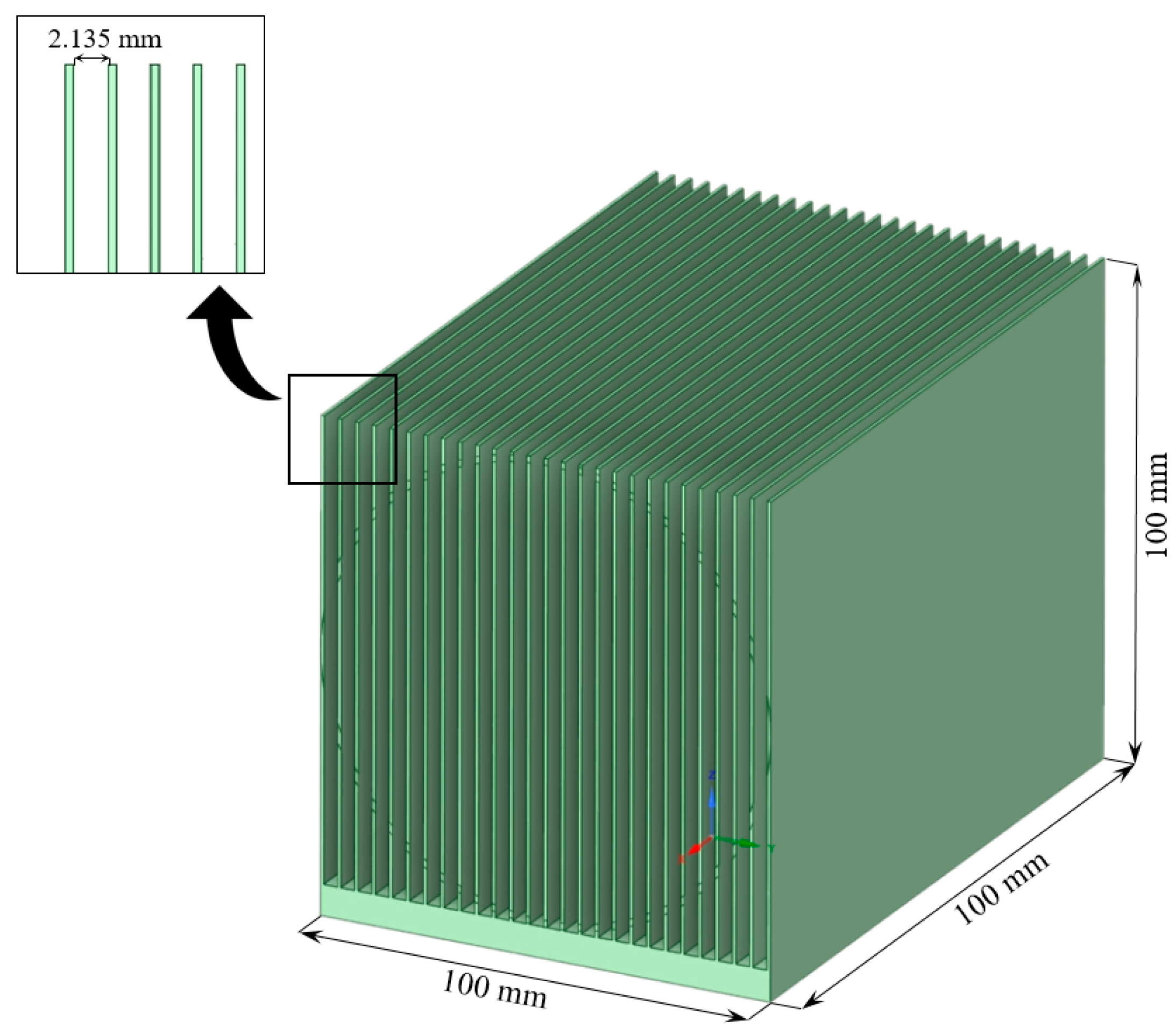
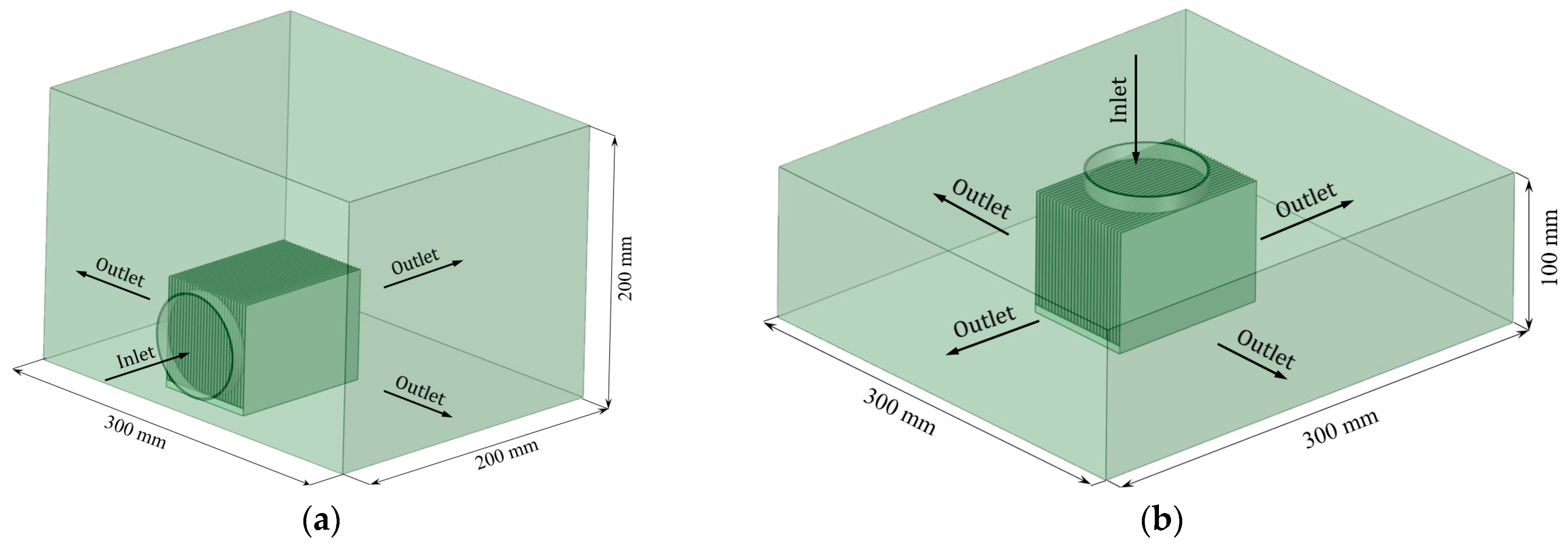
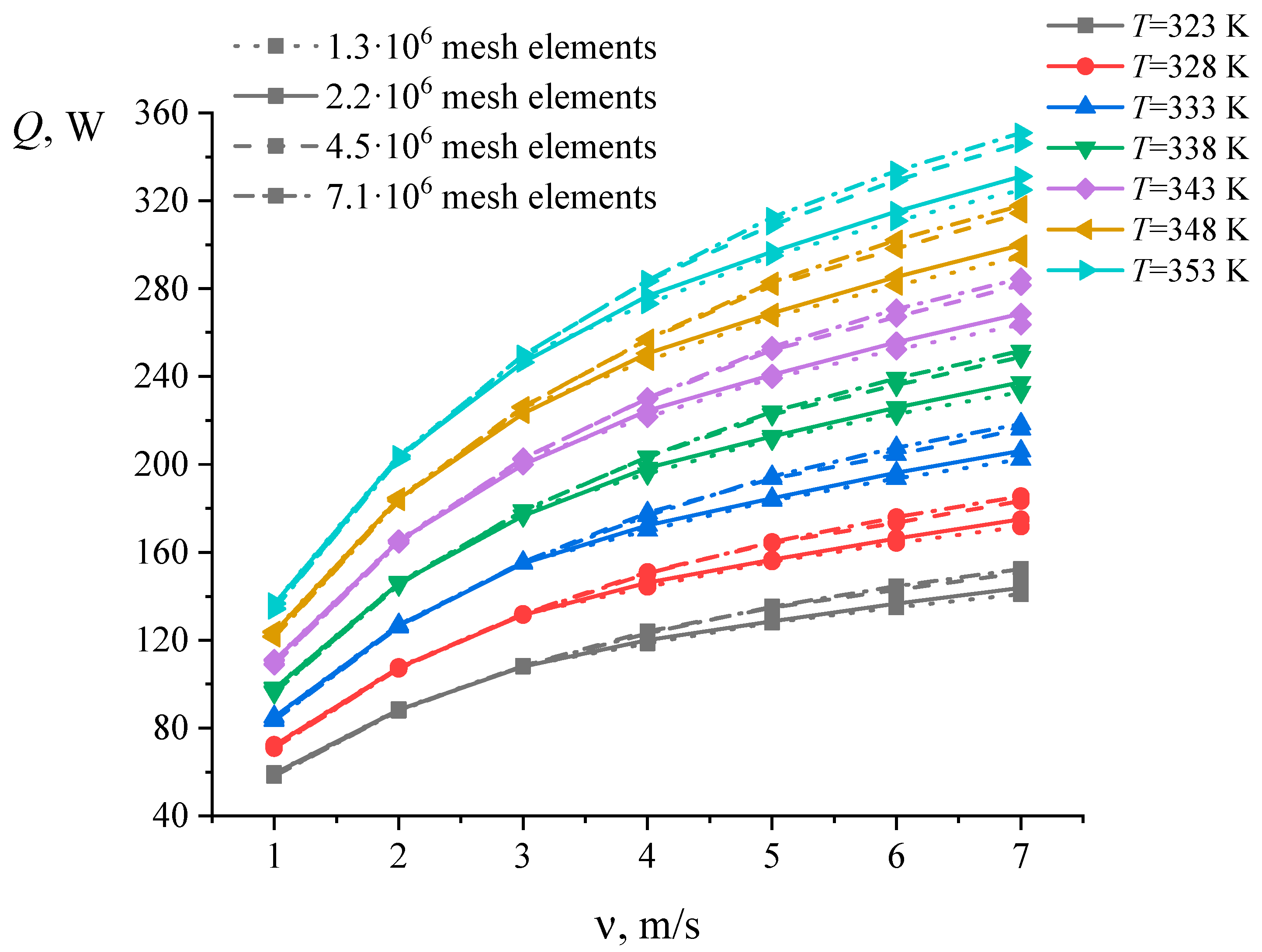


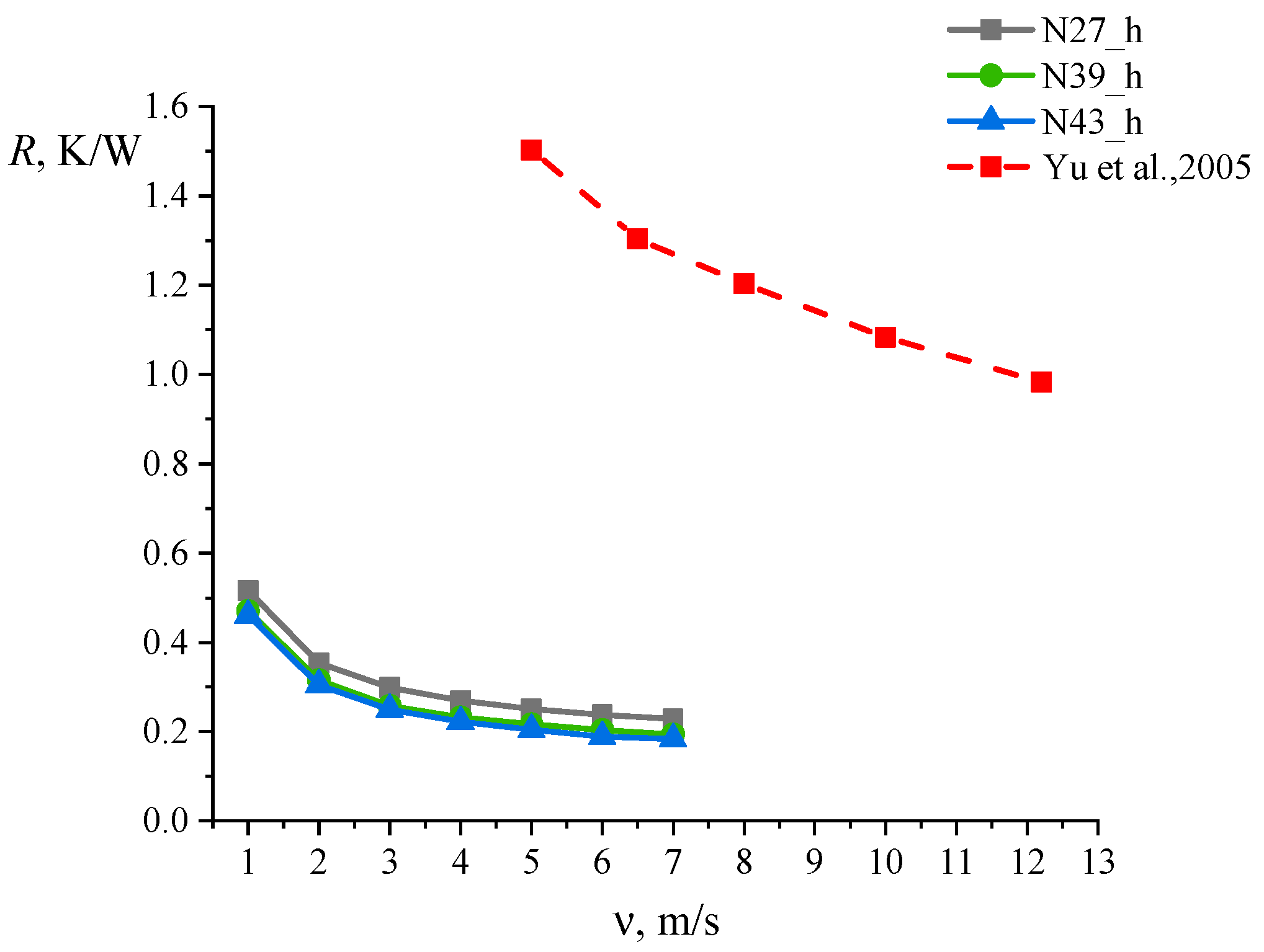
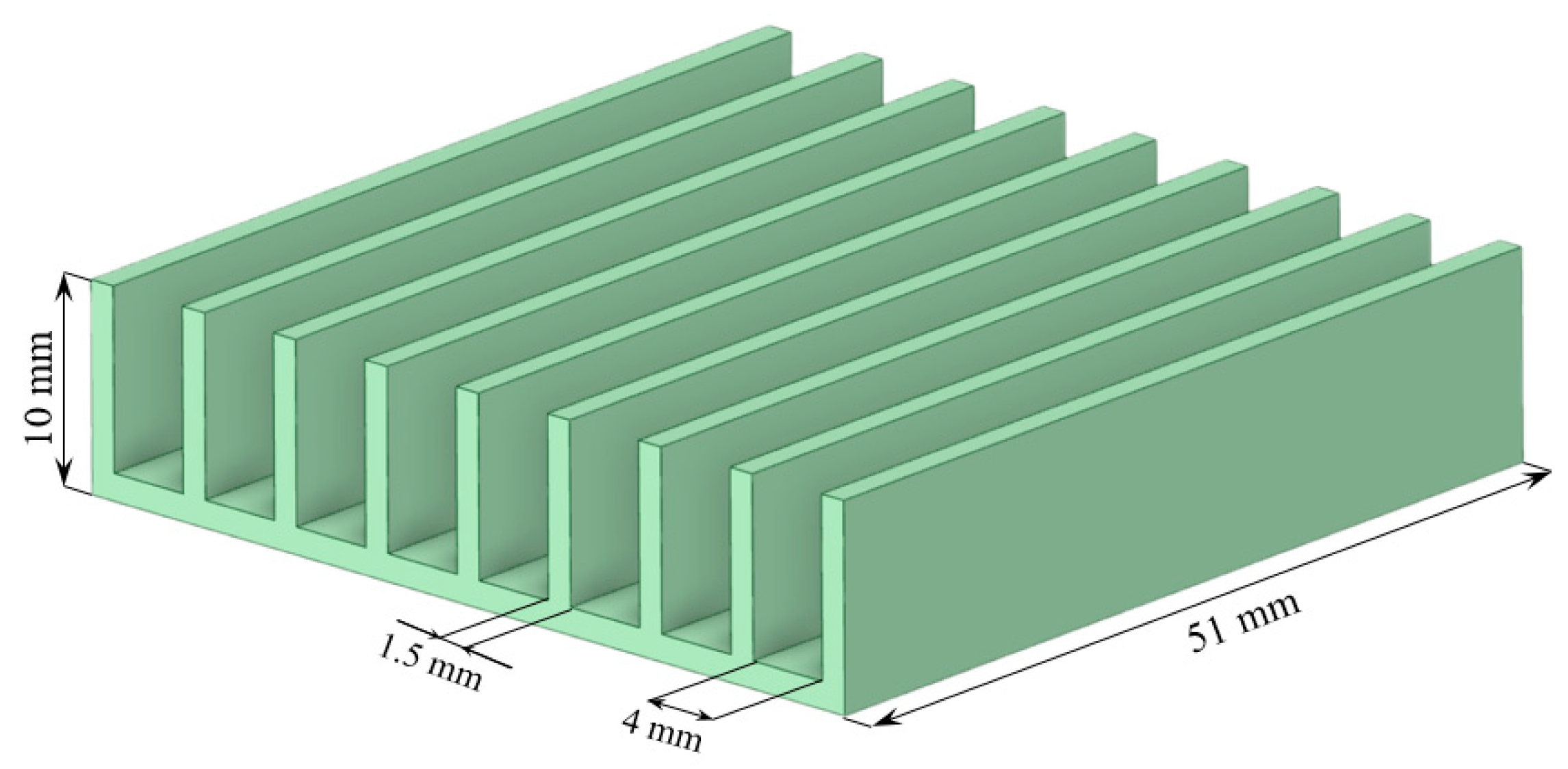
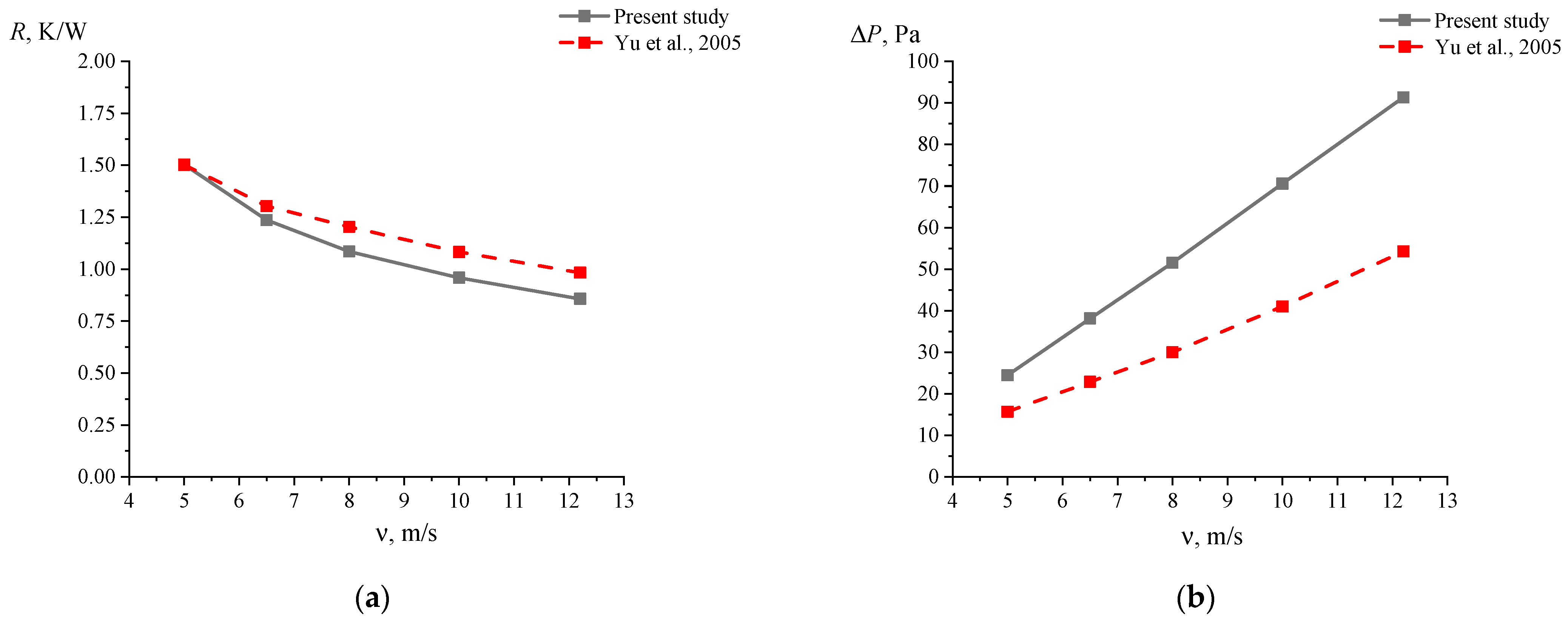

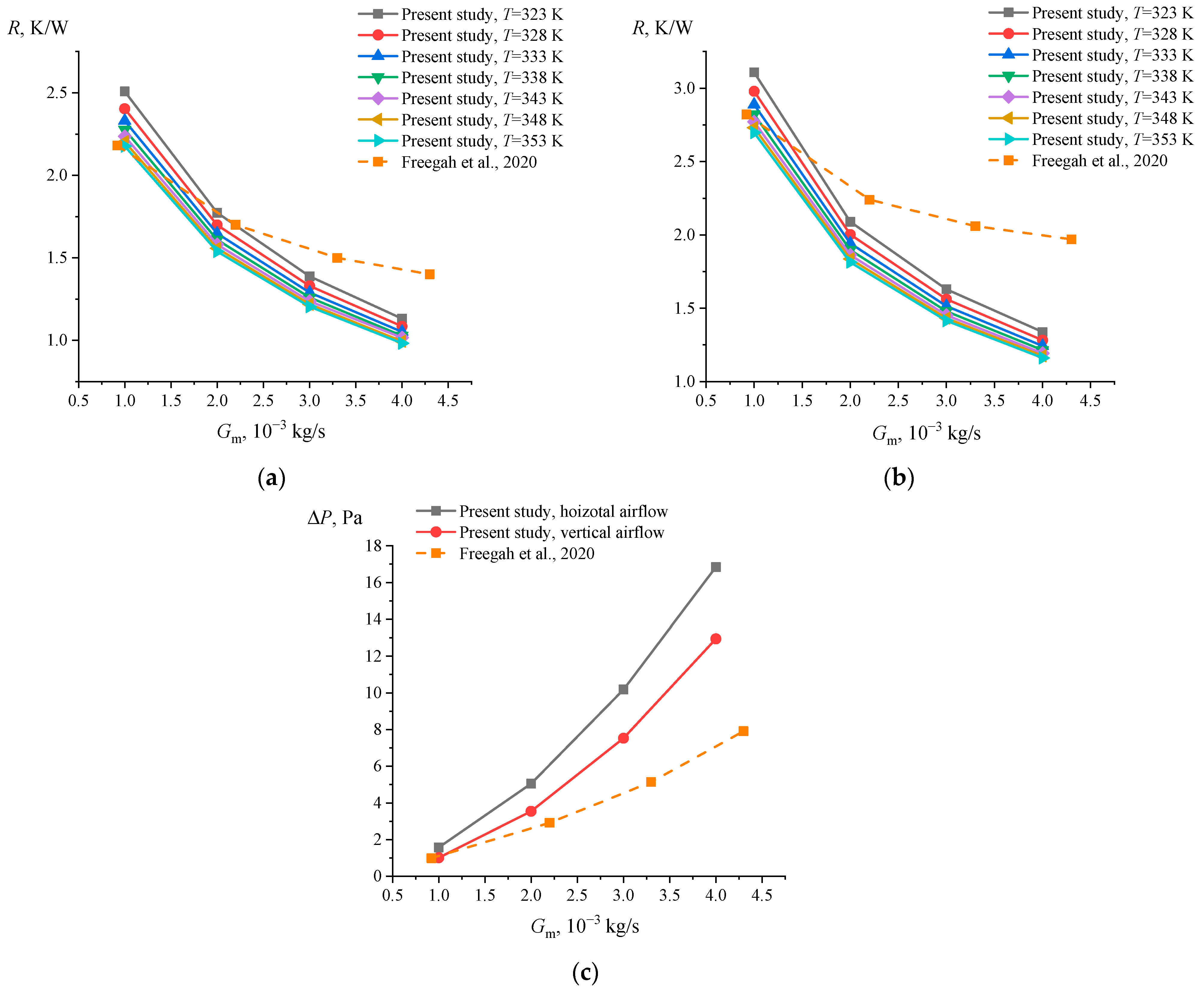

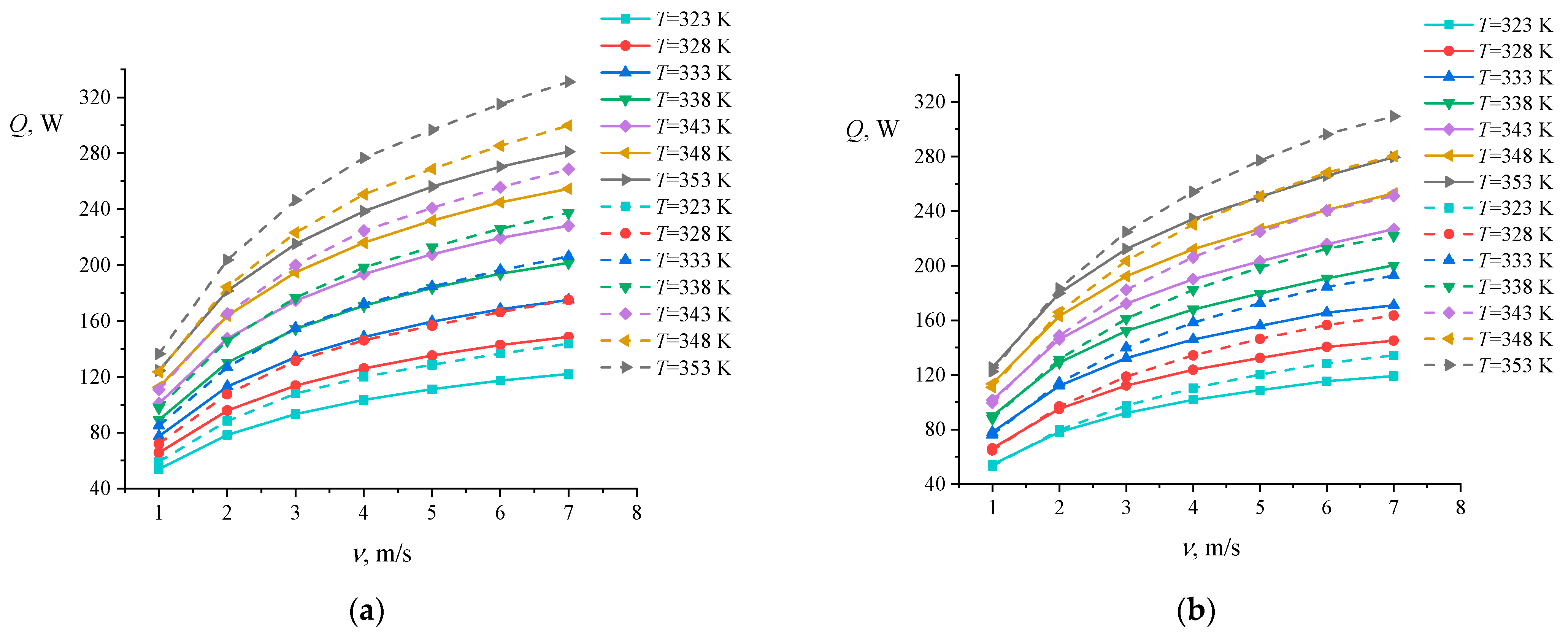
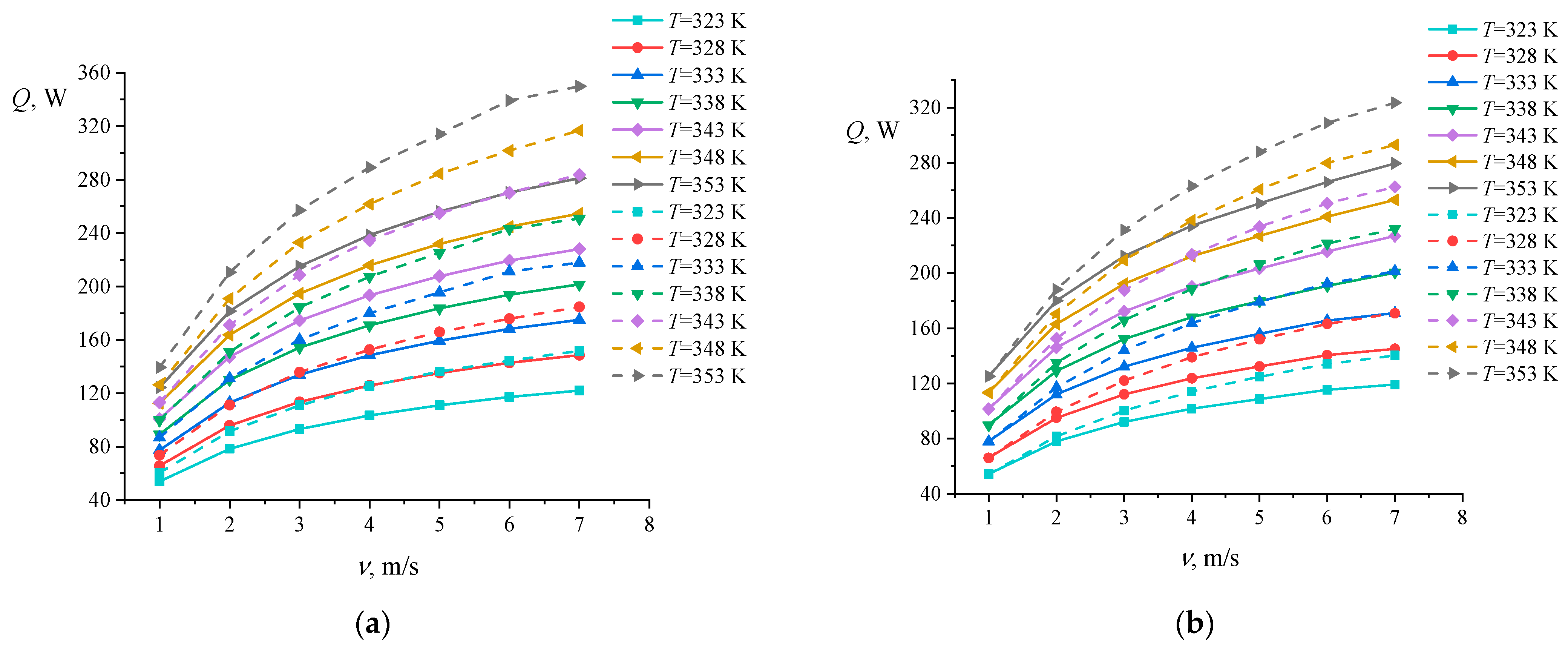
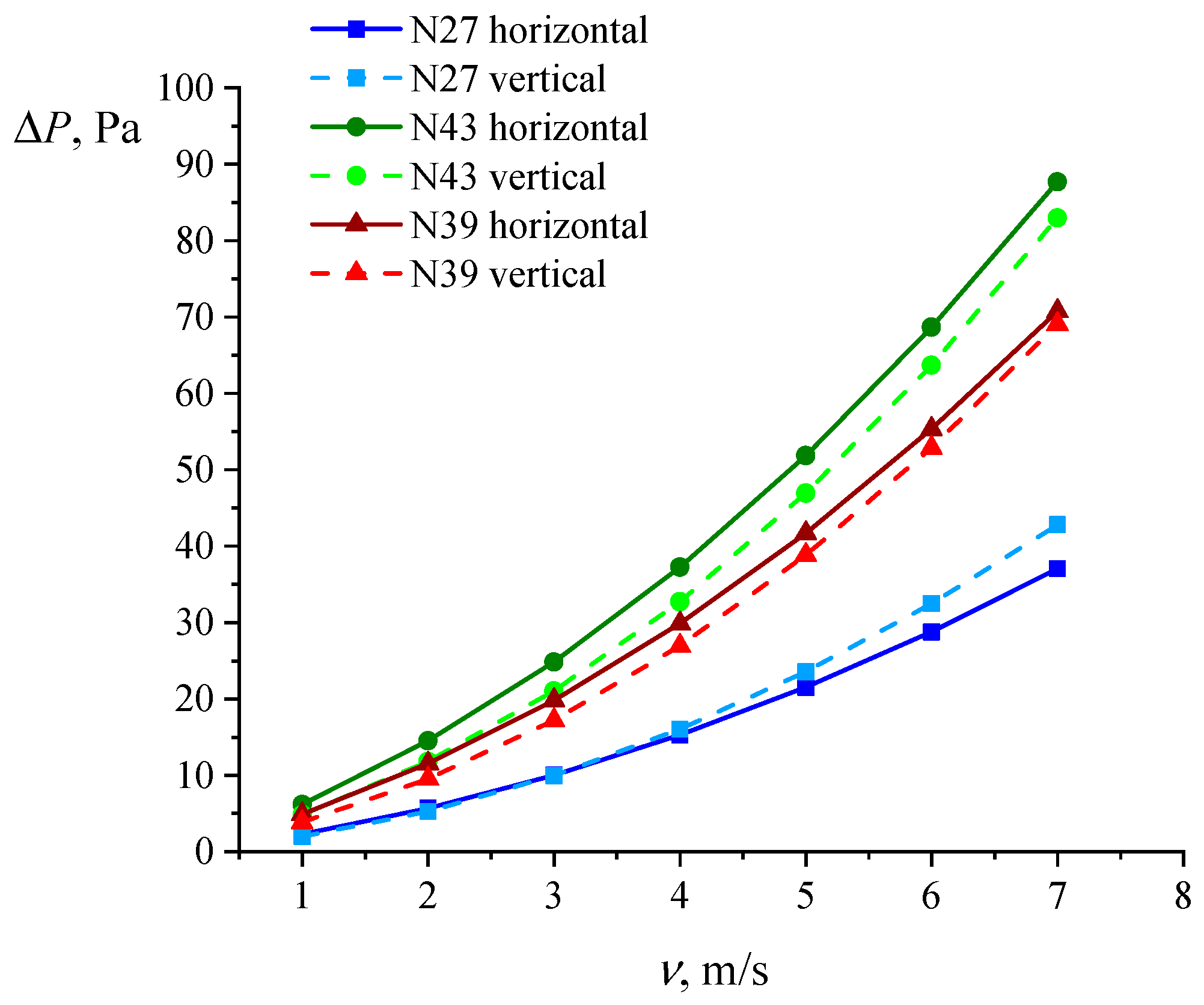
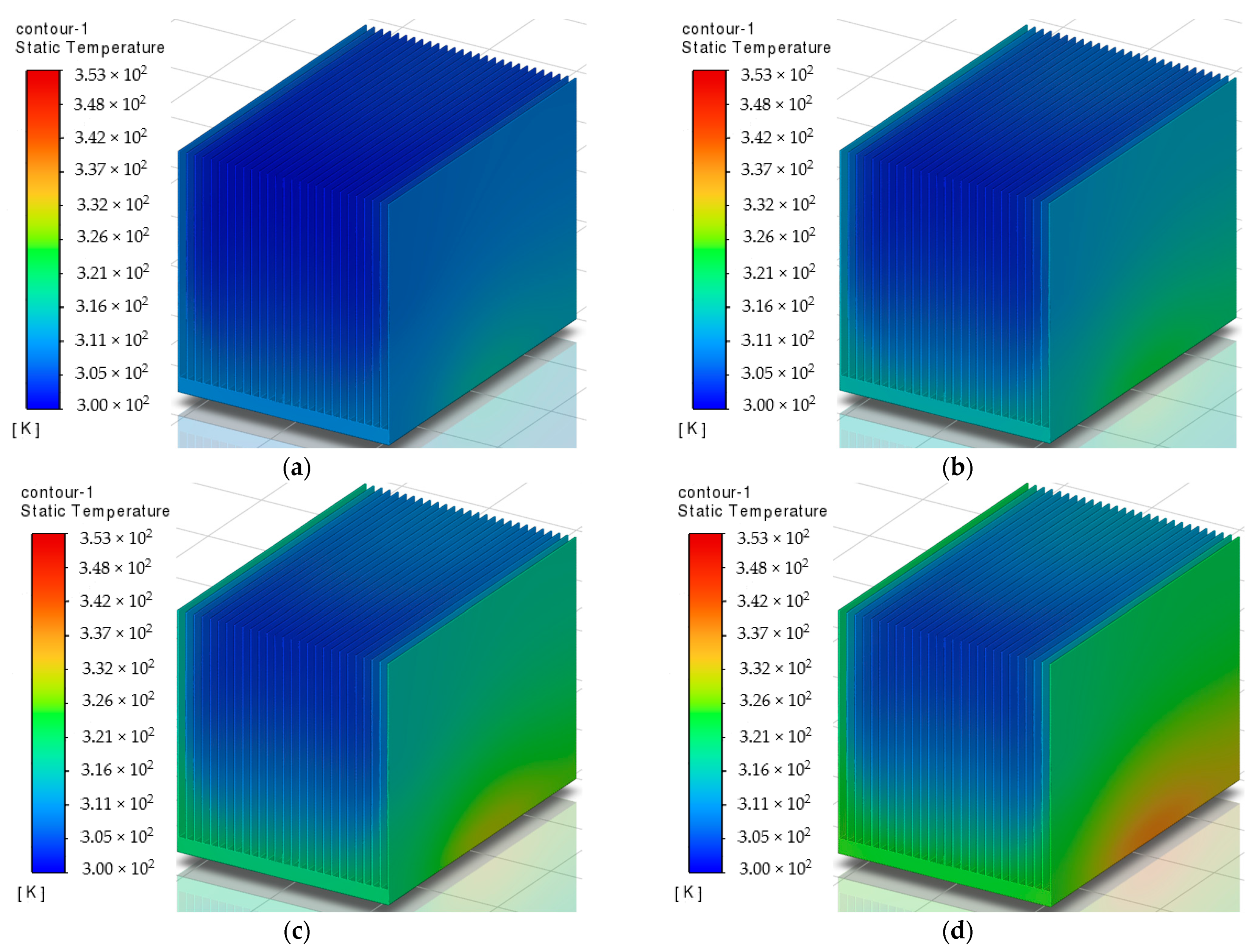
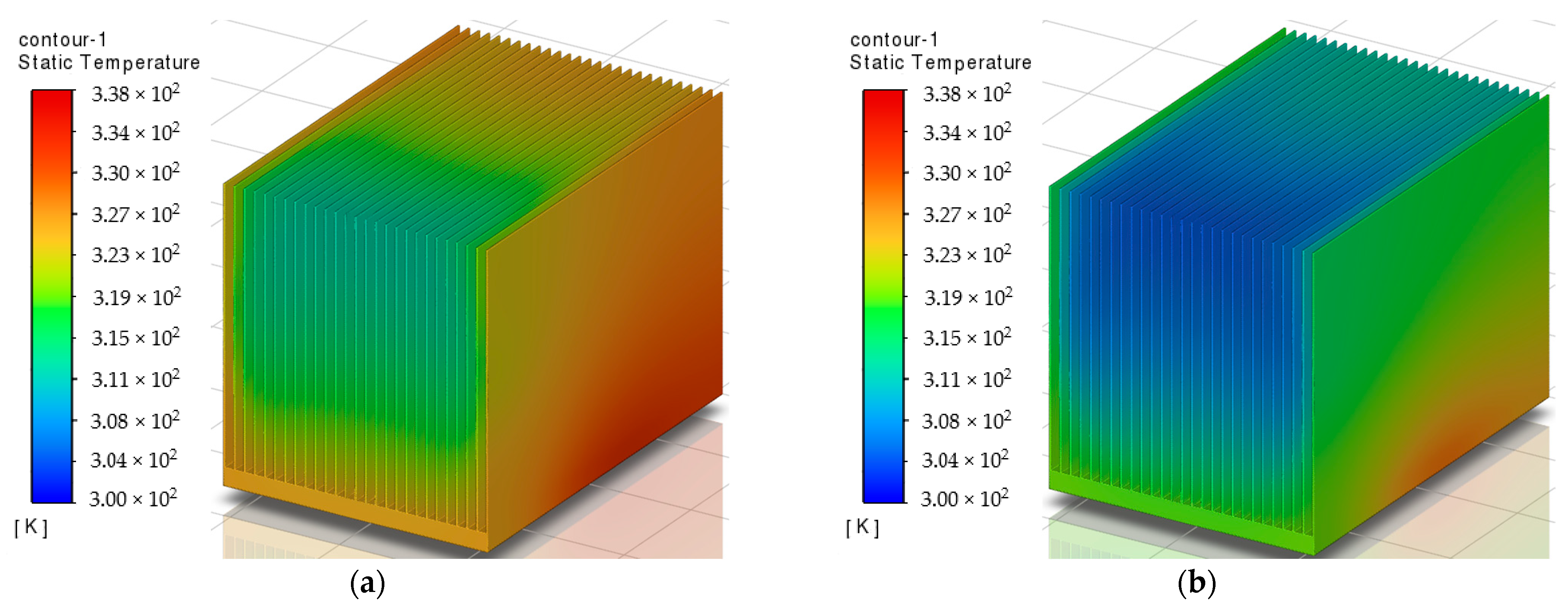




| Name | Number of Fins | Heat Sink Length, mm | Fin Spacing, mm | Surface Area, m2 | Volume of Metal, m3 |
|---|---|---|---|---|---|
| N27 | 27 | 100 | 2.135 | 0.3898 | 1.252 × 10−4 |
| N39 | 39 | 69.9 | 1.3 | 0.3898 | 1.165 × 10−4 |
| N43 | 43 | 69.4 | 1.13 | 0.4256 | 1.252 × 10−4 |
| Heat Sink Model | Airflow Direction | Number of Mesh Elements | Heat Flow, W | Heat Flow Difference, % |
|---|---|---|---|---|
| N39 | Horizontal | 1.3 × 106 | 324.9135 | - |
| 2.2 × 106 | 331.0904 | 1.8656 | ||
| 4.5 × 106 | 346.1906 | 4.3617 | ||
| 7.1 × 106 | 350.8744 | 1.3351 | ||
| Vertical | 1.3 × 106 | 304.9077 | - | |
| 2.3 × 106 | 309.4881 | 1.4800 | ||
| 4.5 × 106 | 311.3529 | 0.5989 | ||
| 6.9 × 106 | 308.8396 | 0.8138 |
Disclaimer/Publisher’s Note: The statements, opinions and data contained in all publications are solely those of the individual author(s) and contributor(s) and not of MDPI and/or the editor(s). MDPI and/or the editor(s) disclaim responsibility for any injury to people or property resulting from any ideas, methods, instructions or products referred to in the content. |
© 2024 by the authors. Licensee MDPI, Basel, Switzerland. This article is an open access article distributed under the terms and conditions of the Creative Commons Attribution (CC BY) license (https://creativecommons.org/licenses/by/4.0/).
Share and Cite
Soloveva, O.V.; Solovev, S.A.; Shakurova, R.Z. Numerical Study of the Thermal and Hydraulic Characteristics of Plate-Fin Heat Sinks. Processes 2024, 12, 744. https://doi.org/10.3390/pr12040744
Soloveva OV, Solovev SA, Shakurova RZ. Numerical Study of the Thermal and Hydraulic Characteristics of Plate-Fin Heat Sinks. Processes. 2024; 12(4):744. https://doi.org/10.3390/pr12040744
Chicago/Turabian StyleSoloveva, Olga V., Sergei A. Solovev, and Rozalina Z. Shakurova. 2024. "Numerical Study of the Thermal and Hydraulic Characteristics of Plate-Fin Heat Sinks" Processes 12, no. 4: 744. https://doi.org/10.3390/pr12040744








